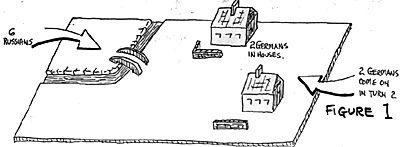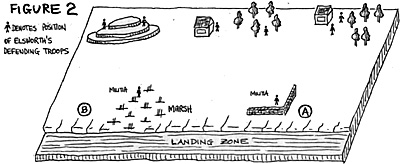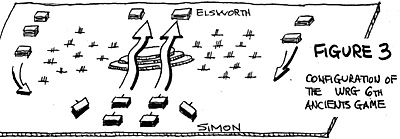 Tom took us to the Wednesday meeting of the Oxford
Polytechnic Wargames Club, where we introduced our modern
skirmish rules to some 7 British players. Jell received, and
lots of interest aborning. We set up a scenario which pitted 6
Russians carrying submachine guns against 4 German riflemen; the
map of Figure 1 indicates that the 6 Russkis are to cross the
river and enter the town wherein 2 of the 4 Germans are hidden.
The other 2 Germans enter the field on the second bound.
Tom took us to the Wednesday meeting of the Oxford
Polytechnic Wargames Club, where we introduced our modern
skirmish rules to some 7 British players. Jell received, and
lots of interest aborning. We set up a scenario which pitted 6
Russians carrying submachine guns against 4 German riflemen; the
map of Figure 1 indicates that the 6 Russkis are to cross the
river and enter the town wherein 2 of the 4 Germans are hidden.
The other 2 Germans enter the field on the second bound.
The first time the scenario was played, the Russians proved overcautious; they moved slowly and srt up no offensive covering fire as their men advanced. As a result, they never even got to cross the bridge. A wipeout! With this in mind, I was rash enough to bet Tom a one pound note (approximately $2) that the Germans could do it again in the second playing, and that the Russians would again never even get a man across the bridge.
In this second run-through, all players shifted sides, and Tom, who was a German in the first game, was a Russian in the second, in charge of 2 Soviet heroes.
And, yup, you guessed it ... Tom's 2 sturdy peasant lads started off at a dead run for the bridge, while the remaining men provided covering fire to keep the Germans pinned. For some reason, the Germans held their fire as the Russians approached, despite my broad hints (which got louder and louder) to bang away at 'em.
The German rifle's probability-of-hit was determined by the equation:
- POH= 99 - (range in inches)
while the submachine gun was
- POH = 59 - (range in inches)
Thus the Germans' probability of hit was some 40 percentage points above the Russians and, in not firing, the German defenders gave away a number of fine opportunities to pot the oncoming Russkis. When the Germans finally did open fire, it was too late; too many Russians too close for comfort. I handed my pound note to Tom midway of the third bound.
The skirmish game proved so interesting that I came up with another rash-proposition, this one concerning our Rhombusian Campaign, which Tom and I had been carrying on across the Atlantic for some time.
In our campaign, my invasion fleet had transported 100 Army Points to a port city held by Elsworthian troops; the defending 44 Army Point Elsworth force was ready to oppose my landing.
My proposition was to play out this armed landing using the modern skirmish rules. Of all the eras and rules I could have chosen for this battle, modern skirmish was probably the worst, since the long range weapons of the defenders made an amphibious assault a rather suicidal operation. But the Lion of Ostlandt would not be stopped!
After much cogitation, Tom and I 'bought' the following forces with our available points:
ELSWORTH
- 2 infantrymen w/SMG
6 infantrymen w/rifle
1 militia infantry w/SMG
1 militia infantryman w/rifle
= 10 men
SIMON
- 3 infantrymen w/SMG
5 infantrymen w/rifle
2 mortar crewmen w/rifle
1 mortar plus 8 mortar rounds
= 10 men
The Elsworth forces were stationed as shown in Figure 2. Tom had placed his militiamen down on the beach; his other men were further inland under cover. The reason for the militia being right up front was simple: there was a 10% chance that the militia, impressed from the Rhombusian provincial forces, might change sides, join me, and start firing on the other Elsworth troops. To counter this, Tom placed the militia well in front of his other men so that, if they did play turncoat, his regular forces could gun the traitors down.
 The bulk of my forces landed at point A in Figure 2; only 2
riflemen were diverted to point B as a flanking force. The 2
militiamen at the beach, while they didn't change sides, proved no
help to Tom.
The bulk of my forces landed at point A in Figure 2; only 2
riflemen were diverted to point B as a flanking force. The 2
militiamen at the beach, while they didn't change sides, proved no
help to Tom.
Their first morale check resulted in a mad riot to safety back up the beach; this left the wall at point A undefended and made the initial stages of the landing much easier than I expected
My mortar crew disembarked late, however; they were slow in setting up and the landing force had trouble holding the wall against the long range rifle fire of the defenders.
Each time the mortar fired, the umpire would designate a coordinate origin within the room, and from this point I would estimate the x and y distances of the desired impact point. My range estimation capabilities were good; each time a round landed, it took a piece out of one of the defenders. However, Tom had dispersed his men effectively and the 10 inch mortar kill radius only chopped up one Elsworthian at a time.
Several bounds later, 2 badly wounded surviving defenders surveyed the beach area where the bodies of my force were stacked. My boys had fought gallantly to the last man; it was a Pyrric victory for Tom... but nonetheless, a victory; for me: a disaster.
Samurai
 Modern skirmish wasn't the only game we played. We engaged in
a WRG 6th Edition Ancients battle in which Tom divided his 15mm
Samurai army in two and we faced each other with 400 point
armies (approximately). Many lucky dice throws later, I had the
Elsworth Samurai on the run, my fierce warriors clobbering away
at the undefended backs of Tom's now panicked troops.
Modern skirmish wasn't the only game we played. We engaged in
a WRG 6th Edition Ancients battle in which Tom divided his 15mm
Samurai army in two and we faced each other with 400 point
armies (approximately). Many lucky dice throws later, I had the
Elsworth Samurai on the run, my fierce warriors clobbering away
at the undefended backs of Tom's now panicked troops.
The terrain was that shown in Figure 3. I sent most of my force directly over the hill in the center, and kept a small unit to defend each flank. Tom sent 3 cavalry units around the marsh on my left flank, and 2 infantry units around on my right.
Both of my defending flank units, when they diced for morale, got out of control and advanced in berserk fashion, chewing up the attacking units in short order. My main attack in the center looked bad for a while until one of Tom's reaction dice throws sent his defenders fleeing. A good day for the Lion!!
Even after my victory, due, of course, to my great dice throwing skill, WRG 6th still looks silly to me. About the best I can say for it is that it is formalized and regulated, so that all who play it can indulge in a sort of 'standardized silliness' the world over.
More And a Good Time Was Had By All
-
UK Wargaming: Introduction
Oxford Polytechnic Wargames Club: WWII and Samurai
Napoleonic Battle: Column, Line, Square
Monopoly
Back to PW Review December 1981 Table of Contents
Back to PW Review List of Issues
Back to MagWeb Master Magazine List
© Copyright 1981 Wally Simon
This article appears in MagWeb (Magazine Web) on the Internet World Wide Web.
Other military history articles and gaming articles are available at http://www.magweb.com